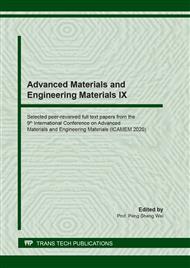[1]
A. K. Padhi, K. S. Nanjundaswamy, J. B. Goodenough, Phospho-olivines as positive-electrode materials for rechargeable lithium batteries, J. Electrochem. Soc. 144 (1997) 1188-1194.
DOI: 10.1149/1.1837571
Google Scholar
[2]
J. M. Tarascon, M. Armand, Issues and challenges facing rechargeable lithium batteries, Nature. 414 (2001) 359–367.
DOI: 10.1038/35104644
Google Scholar
[3]
J. Gaubicher, T. L. Mercier, Y. Chabre, J. Angenault and M. Quarton, Li/β-VOPO4: a new 4 V system for lithium batteries, J. Electrochem. Soc. 146 (1999) 4375–4379.
DOI: 10.1149/1.1392646
Google Scholar
[4]
S. Y. Chung, J. T. Bloking, Y. M. Chiang, On the electronic conductivity of phospho-olivines as lithium storage electrodes, Nat. Mater. 2 (2003) 702-703.
DOI: 10.1038/nmat1009b
Google Scholar
[5]
H. Huang, S. C. Yin, L. F. Nazar, Approaching theoretical capacity of LiFePO4 at room temperature at high rates, Electrochem. Solid-State. Lett. 4 (2001) A170-A172.
DOI: 10.1149/1.1396695
Google Scholar
[6]
Z. Xin-wen, Z. Dan, W. Li-na, L. Qiao-yun, Z. Hong-xing and Z. Ke-li, Synthesis, characterization and properties of LiFePO4/C cathode material, Wuhan Univ. J. Nat. Sci. 10 (2005) 909-912.
DOI: 10.1007/bf02832437
Google Scholar
[7]
T. Maxisch, F. Zhou, G. Ceder, Ab initio study of the migration of small polarons in olivine LixFePO4 and their association with lithium ions and vacancies, Phys. Rev. B. 73 (2006) 1–6.
DOI: 10.1103/physrevb.73.104301
Google Scholar
[8]
Y. Gu, M. Weng, G. Teng, H. Zeng, J. Jie, W. Xiao, J. Zheng and F. Pan, Tuning polaronic redox behavior in olivine phosphate, Phys. Chem. Chem. Phys. 21 (2019) 4578–4583.
DOI: 10.1039/c8cp06083e
Google Scholar
[9]
K. Hoang, M. D. Johannes, First-principles studies of the effects of impurities on the ionic and electronic conduction in LiFePO4, J. Power. Sources. 206 (2012) 274–281.
DOI: 10.1016/j.jpowsour.2012.01.126
Google Scholar
[10]
C. L. Fan, C. R. Lin, S. C. Han, J. Chen, L. F. Li, Y. M. Bai, K. H. Zhang and X. Zhang, Structure, conductive mechanism and electrochemical performances of LiFePO4/C doped with Mg2+, Cr3+ and Ti4+ by a carbothermal reduction method, New J. Chem. 38 (2014) 795–801.
DOI: 10.1039/c3nj01285a
Google Scholar
[11]
M. Wagemaker, B. L. Ellis, D. L. Hecht, F. M. Mulder and L. F. Nazar, Proof of supervalent doping in olivine LiFePO4, Chem. Mater. 20 (2008) 6313-6315.
DOI: 10.1021/cm801781k
Google Scholar
[12]
G. X. Wang, S. Bewlay, S. A. Needham, H. K. Liu, R. S. Liu, V. A. Drozd, J. F. Lee and J. M. Chen, Synthesis and characterization of LiFePO4 and LiuTi0.01Fe0.99PO4 cathode materials, J. Electrochem. Soc. 153 (2006) A25-A31.
DOI: 10.1149/1.2128766
Google Scholar
[13]
G. Kresse, J. Furthmüller, Efficiency of ab-initio total energy calculations for metals and semiconductors using a plane-wave basis set, Comput. Mat. Sci. 6 (1996) 15-50.
DOI: 10.1016/0927-0256(96)00008-0
Google Scholar
[14]
G. Kresse, J. Furthmüller, Efficient iterative schemes for ab initio total-energy calculations using a plane-wave basis set, Phys. Rev. B. 54 (1996) 11169-11186.
DOI: 10.1103/physrevb.54.11169
Google Scholar
[15]
P. E. Blochl, Projector augmented-wave method, Phys. Rev. B. 50 (1994) 17953–17979.
DOI: 10.1103/physrevb.50.17953
Google Scholar
[16]
G. Kresse, D. Joubert, From ultrasoft pseudopotentials to the projector augmented-wave method, Phys. Rev. B. 59 (1999) 1758–1775.
DOI: 10.1103/physrevb.59.1758
Google Scholar
[17]
J. P. Perdew, K. Burke, M. Ernzerhof, Generalized gradient approximation made simple, Phys. Rev. Lett. 77 (1996) 3865–3868.
DOI: 10.1103/physrevlett.77.3865
Google Scholar
[18]
S. L. Dudarev, G. A. Botton, S. Y. Savrasov, C. J. Humphreys and A. P. Sutton, Electron-energy-loss spectra and the structural stability of nickel oxide: an LSDA+U study, Phys. Rev. B. 57 (1998) 1505–1509.
DOI: 10.1103/physrevb.57.1505
Google Scholar
[19]
G. K. P. Dathar, D. Sheppard, K. J. Stevenson and G. Henkelman, Calculations of Li-ion diffusion in olivine phosphates, Chem. Mater. 23 (2017) 4032–4037.
DOI: 10.1021/cm201604g
Google Scholar
[20]
M. Nishijima, T. Ootani, T. Kamimura, T. Sueki, S. Esaki, S. Murai, K. Fujita, K. Tanaka, K. Ohira, Y. Koyama and I. Tanaka, Accelerated discovery of cathode materials with prolonged cycle life for lithium-ion battery, Nat. Commun. 5 (2014) 1-7.
DOI: 10.1038/ncomms5553
Google Scholar
[21]
H. J. Monkhorst, J. D. Pack, Special points for brillouin-zone integrations, Phys. Rev. B. 13 (1976) 5188–5192.
DOI: 10.1103/physrevb.13.5188
Google Scholar
[22]
G. Rousse, L. R. Carvajal, S. Patoux and C. Masquelier, Magnetic structures of the triphylite LiFePO4 and of its delithiated form FePO4, Chem. Mater. 15 (2003) 4082–4090.
DOI: 10.1021/cm0300462
Google Scholar
[23]
G. Henkelman, H. Jonsson, A climbing image nudged elastic band method for finding saddle points and minimum energy paths, J. Chem. Phys. 113 (2000) 9901–9904.
DOI: 10.1063/1.1329672
Google Scholar
[24]
S. Li, M. S. Sellers, C. Basaran, A. J. Schultz and D. A. Kofke, Lattice strain due to an atomic vacancy, Int. J. Mol. Sci. 10 (2009) 2798–2808.
DOI: 10.3390/ijms10062798
Google Scholar
[25]
M. E. A. Dompablo, A. M. García, M. Taravillo, DFT+U calculations of crystal lattice, electronic structure, and phase stability under pressure of TiO2 polymorphs, J. Chem. Phys. 135 (2011) 1-9.
DOI: 10.1063/1.3617244
Google Scholar
[26]
H. Jin, E. Debroye, M. Keshavarz, I. G. Scheblykin, M. B. J. Roeffaers, J. Hofkens and J. A. Steele, It's a trap! on the nature of localised states and charge trapping in lead halide perovskites, Mater. Horiz. 7 (2020) 397–410.
DOI: 10.1039/c9mh00500e
Google Scholar


